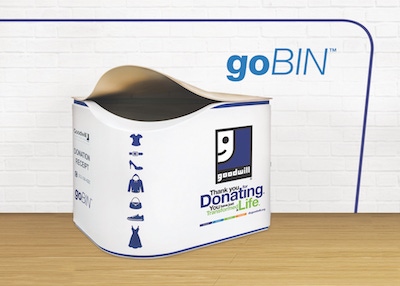Cost, lightweighting and aesthetics made thermoforming the optimal choice for manufacturing Goodwill��’s new compact donation bins for apartment and office lobbies.
November 22, 2016

When people want to make something big, there are hundreds of processes from which to choose. But the three processes we see “competing” most often are thermoforming, injection molding and fiberglass.
Even as a thermoformer, we recognize that no single process is right for every project, but taking into account some key factors can ease the decision-making process.
 Earlier this year, Ray Products (Ontario, CA) had the opportunity to work with Goodwill to manufacture its brand new GoBINs. GoBINs are small-scale donation bins designed for lobbies of apartment buildings and office complexes. They make it easy for residents to donate to Goodwill, especially in high-density urban environments where many people don’t have cars.
Earlier this year, Ray Products (Ontario, CA) had the opportunity to work with Goodwill to manufacture its brand new GoBINs. GoBINs are small-scale donation bins designed for lobbies of apartment buildings and office complexes. They make it easy for residents to donate to Goodwill, especially in high-density urban environments where many people don’t have cars.
The factors that led Goodwill to choose thermoforming are relevant to nearly every large-scale plastic manufacturing project.
The first consideration of nearly every project is cost. What does it cost to make a mold, and what does it cost to make each individual part?
Those costs usually are tied to two significant factors: Size and quantity.
GoBINs are about the size of a desk—around 4 1/4 feet long by 3 feet high and a bit over 3 feet deep. In terms of quantity, Goodwill wanted to scale manufacturing to meet demand as the program expands to cities around the country. Each individual batch could range from fewer than one hundred units to the low thousands.
If Goodwill had been planning to make just 10 or 20 units, fiberglass might have been the best option, given its low tooling and higher per-unit costs. On the other hand, if they were going to make 100,000 units in a single run, injection molding might have become cost effective, even with its high tooling costs for large parts.
But, like Mama Bear’s chair in the Goldilocks story, thermoforming was just right. Thermoforming tooling for the project cost less than 1/20th of what injection molding tooling would have cost. And thermoforming’s per-part production cost savings won out over fiberglass.
With many projects, being the most cost-effective option is enough to be selected, but Goodwill was looking for more. For a start, the bins needed to be lightweight, durable and easy to ship and assemble.
Here again, thermoforming was the right choice. On average, thermoformed parts are about 30% lighter than equivalent fiberglass parts. Material selection and design can drive those savings even higher. For Goodwill, weight reduction resulted in a bin that cost less to ship and was easier to assemble, all without sacrificing durability.
Goodwill was also concerned about aesthetics. It wanted a bin that wouldn’t look out of place in a beautiful apartment building’s lobby. Choosing thermoforming allowed GoBINs to be molded in a high-gloss, custom color, and eliminated the need for paint. As a result, Goodwill was able to create a beautiful final product, while saving significantly on finishing costs.
Finally, Goodwill wanted a sustainable, domestic manufacturing process. Thermoforming fit the bill there, too, as it is a 100% recyclable manufacturing process, and we helped them tick off the domestic box (and further reduce shipping costs) with our California manufacturing facility.
For Goodwill, the choice was easy, and today their GoBINs have been deployed in major metropolitan areas around the country. I’ll be the first to admit that thermoforming’s not the right choice for every project, but if it’s the right process for your next project, the advantages can be too big to ignore.
Jason Middleton is Vice President of Sales and Development at Ray Products, a thermforming company headquartered in Ontario, CA, that has served an array of industries for more than 60 years.
About the Author(s)
You May Also Like


